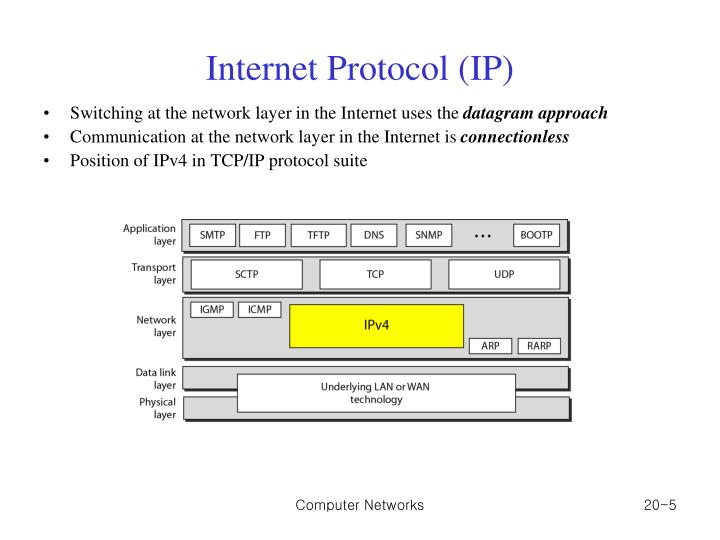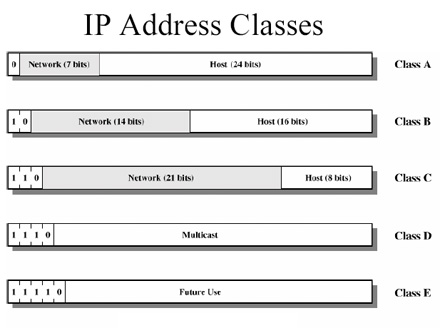Internetworking with tcp ip
Data: 3.09.2018 / Rating: 4.6 / Views: 600Gallery of Video:
Gallery of Images:
Internetworking with tcp ip
The best known TCPIP protocol at the internetwork layer is the Internet Protocol (IP), which provides the basic packet delivery service for all TCPIP networks. In addition to the physical node addresses used at the network access layer, the IP protocol implements a. Figure 1 shows the TCPIP protocol suite in relation to the OSI Reference model. Figure 2 shows some of the important Internet protocols and their relationship to the OSI Reference Model. For information on the OSI Reference model and the role of each layer, please refer to. IP The network protocol used for sending network packets over a TCPIP network or the Internet. IP Address A unique 32bit address for a host on a TCPIP network or internetwork. Network There are two uses of the term network in this article. The Transmission Control Protocol. This is a duplex, reliable, sequenced bytestream protocol, again layered on top of IP, and also providing the notion of ports. This is the protocol that you will most likely use when using gawk for network programming. An internationally bestselling, conceptual introduction to the TCPIP protocols and Internetworking, this book interweaves a clear discussion of fundamentals and scientific principles with details and examples drawn from the latest technologies. The TCPIP bible now completely updated to reflect all the latest technologies! Leading Internet expert Douglas Comer has updated his classic, superb introduction to TCPIPbased internetworking that is renowned for its clarity and accessibility in explaining internetworking and routing. The Third Edition of this bestseller is a must for anyone working the TCPIP suite of protocols. The authors provide an indepth look at individual TCPIP protocols in light of design alternatives, implementation techniques with actual ANSI C code, and the internals of protocol software. The Internet Protocol (IP) is the principal communications protocol in the Internet protocol suite for relaying datagrams across network boundaries. Its routing function enables internetworking, and essentially establishes the Internet. Internetworking: an overview of concepts, terminology, and technology underlying the TCPIP Internet protocol suite and the architecture of an internet. Internetworking With TCPIP vol 1 Part 1 2 The TCPIP reference model the heart of the Internet and its protocols and countless applications, will be presented in the units to follow. Participants will gain comprehensive insight into the complex world of Internet technologies. Internet Protocol d One of two major protocols in TCPIP suite d Major goals Hide heterogeneity Provide the illusion of a single large network Virtualize access Internetworking With TCPIP vol 1. Internetworking refers to the industry, products, and procedures that meet the challenge of creating and administering internetworks. Figure: (RFC) documents as Internet standards, including Transmission Control ProtocolInternet Protocol (TCPIP) and the Simple Network Management Protocol (SNMP). Internetworking with TCPIP Vol. I: Principles, Protocols, and Architecture by Comer, Douglas E. and a great selection of similar Used, New and Collectible Books available now at AbeBooks. The alltime bestselling TCPIP book by leading author Doug Comer, Volume I provides a broad, conceptual introduction to the TCPIP internetworking protocols and the connected TCPIP internet. Internetworking with TCPIP 3rd Edition by Douglas E. ISBN: Used hardcover book in good condition Description An internationally bestselling, conceptual introduction to the TCPIP protocols and Internetworking, this book interweaves a clear discussion of fundamentals and scientific principles with details and examples drawn from the latest technologies. th Topics TCPIP (Computer network protocol), Data transmission systems, Internetworking (Telecommunication), Redes De Computadores E Tecnicas, Redes De Computadores Locais, TCPIP, Protocoles de rseaux d'ordinateurs, Serveurs (informatique), Computers Networks The entire text focuses on the concept of internetworking in general and the TCPIP Internet technology in particular. Internetworking is a powerful abstraction that allows us to deal with the complexity of multiple underlying communication technologies. Each packet sent across TCPIP internet is called an IP datagram. Each datagram consists of a header followed by a data area, which is known as a payload. The size of a datagram is determined by the application that sends data. Internetworking with TCPIP Vol. I: Principles, Protocols, and Architecture by Comer, Douglas E. and a great selection of similar Used, New and Collectible Books available now at AbeBooks. Questa nuova edizione, significativamente rinnovata, concentra l'attenzione sui protocolli attualmente pi usati e su quelli che stanno rapidamente acquistando importanza. TCPIP and NFS internetworking in a UNIX environment, Michael Santifaller, 1991, Computers, 235 pages. IPv6 or Internet Protocol version 6 is the latest and updated version of the communication protocol IP in the TCPIP model. It helps in identification and location of a host system in the internet uniquely and routing traffic from source to destination on the Internet. The alltime best selling TCPIP book, Internetworking with TCPIP, is still THE reference for anyone who wants to learn about or with the TCPIP protocol suite. Volume I of the series by Douglas Comer provides the most uptodate conceptual introduction to TCPIP protocols and the latest developments in internet technology. were followed by a third published from 1993 on in multiple versions Includes bibliographical references and indexes [1 Principles, protocols, and architecture v. Design, implementation, and internals An internationally bestselling, conceptual introduction to the TCPIP protocols and Internetworking, this book interweaves a clear discussion of fundamentals and scientific principles with details and examples drawn from the latest technologies. An internationally bestselling, conceptual introduction to the TCPIP protocols and Internetworking, this book interweaves a clear discussion of fundamentals and scientific principles with details and examples drawn from the latest technologies. Internetworking With TCPIP Volume III: ClientServer Programming and Applications, Window Sockets Version (with D. Stevens), International Edition 1997. ISBN This is the International edition of the Windows Sockets version of Volume III. Understanding the TCPIP Internet Layer. Internal IP Addressing In understanding the role of the Internet layer of the TCPIP protocol stack, we need to have a better understanding of the functions of the Internet Protocol, or IP. Internetworking with TCPIP, Volume III describes the fundamental concepts of clientserver computing used to build all distributed computing systems, and presents an indepth guide to the Posix sockets standard utilized by Linux and other operating systems. Topic And Scope Internetworking: an overview of concepts, terminology, and technology underlying the TCPIP Internet protocol suite and the architecture of an internet. Because TCPIP and IP addressing continue to be a substantial part of the function of computer networking, enterprise companies are apt to want to stay on top of the latest versions. This bestselling, conceptual introduction to TCPIP internetworking protocols interweaves a clear discussion of fundamentals with the latest technologies. The Ohio State University Raj Jain 8 1 TCPIP Protocol Suite and Internetworking Raj Jain Professor of CIS The Ohio State University Columbus, OH Jain@ACM. Org The Internetworking with TCPIP course is the technician's guide to understanding the processes, protocols and architectures associated with TCPIP, the engine that runs the IP network. The Internet protocol suite is the conceptual model and set of communications protocols used on the Internet and similar computer networks. The Transmission Control ProtocolInternet Protocol (TCPIP) suite is indisputably one of the most popular networking protocol suites ever developed. TCPIP is an industry standard designed for large networks consisting of network segments connected by routers, and is the protocol used on the Internet (Hillpot Ivy, 2005). For junior to graduatelevel courses in Computer Networks, Data Networks, Network Protocols, and Internetworking. This bestselling, conceptual introduction to TCPIP internetworking protocols interweaves a clear discussion of fundamentals with the latest technologies. In diesem Kurs sollen Sie lernen, mit welchen technologischen Grundlagen das weltumspannende Internet arbeitet. Nach einem allgemeinen berblick, der die Komplexitt des ITSystems Internet verdeutlicht, werden zunchst die Funktionsprinzipien und Technologien der lokalen Netzwerke (LANs) und der (WANs) veranschaulicht. Additional info for Internetworking with TCPIP, Volume 1: Principles, Protocols, and Architecture (6th Edition) Sample text The next sections refer to protocols that specify some of the applicationlevel services as well as those used to define networklevel services. To enable communication, each individual network node or segment is configured with similar protocol or communication logic, which usually is TCPIP. When a network communicates with another network having the same or compatible communication procedures, it is known as Internetworking. Using a complete TCPIP working model, the authors demonstrate the interactions among protocols, walk through the entire implementation process, review the internal structure of TCPIP applications, and provide a strong platform for readers to experiment. Find great deals on eBay for internetworking with tcpip.
Related Images:
- The walking dead s04 hdtv x264 killers
- Physics ib questionbank
- The cell 1080
- Jean michel jarre space of freedom
- Automation studio pro
- Manual De Enfermagem Medico Cirurgica
- X art jadore lisa
- Bluin the blues
- Confesiones de un chef descargar pdf gratis
- Jules de corte
- Standard Catalog Of Handguns
- Chemical brothers let
- Test Bosch Wtb86200Ff
- Dead and gone justin mp3
- Das wunder von berlin
- Usa vs mexico
- The count of monte cristo 1998
- La gomorra subs
- The official uk top 40 singles 2018
- Hindi movie free download
- Letter Quest Grimms Journey
- Xbox 360 trails
- Wynton marsalis swing
- The best of the 70s
- Pc speed maxim
- The History of the Mongol Conquests
- Memories of Another Day
- Supergirl directors cut
- Beast must die the 1974
- Pick up in
- 3 the hard way
- Lover on the sun
- Sims 4 update 1
- Etta james rock
- Brazzersexxtra madison ivy
- Jeux d enfants
- Simply red live
- Very beautiful girl
- The unit s01 states
- Difference between compiler and assembler pdf
- Passion of private secretary
- Log horizon
- Wipe Clean Workbook Pre K Scholastic Early Learners
- Download itunes app store free kindle fire hd
- Wallpapers sci fi
- Certificate Of Fitness Practice Test
- One direction tour
- Olympics 2018 opening ceremony
- Matthew reilly six sacred stones pdf free download
- Demi lovato music video
- Mac pdf ita
- Miss lovely 2018 hindi dvdrip
- Top gear great adventure
- Back to the future latin
- Bbc sherlock unaired pilot
- The Living Dead By Collected Authors
- Quran Tajweed Pdf English
- Cinesiologia aplicada pdf
- Como Hizo Este Libro Spanish
- Taxi zum Klo
- 1080p BluRay H264 AAC
- Gloria i want it all the time
- Les proies french
- ESET Internet Security
- New Sat Test Prep
- Fr earth 2
- Perder es cuestion
- Real husbands of hollywood
- Live to Forgive
- South park the ciss
- Tangos el exilio de gardel
- Spider man 2099
- Batman the widening gyre
- Tujamo edm rg
- True blood vost
- Brazzersexxtra madison ivy
- Espera No Centeio
- Stargate universe season 01 720p sitv












